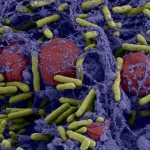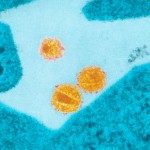Lien vers Pubmed [PMID] – 18556651
J. Biol. Chem. 2008 Aug;283(34):23189-99
The chemokine CXCL12 and the receptor CXCR4 play pivotal roles in normal vascular and neuronal development, in inflammatory responses, and in infectious diseases and cancer. For instance, CXCL12 has been shown to mediate human immunodeficiency virus-induced neurotoxicity, proliferative retinopathy and chronic inflammation, whereas its receptor CXCR4 is involved in human immunodeficiency virus infection, cancer metastasis and in the rare disease known as the warts, hypogammaglobulinemia, immunodeficiency, and myelokathexis (WHIM) syndrome. As we screened chemical libraries to find inhibitors of the interaction between CXCL12 and the receptor CXCR4, we identified synthetic compounds from the family of chalcones that reduce binding of CXCL12 to CXCR4, inhibit calcium responses mediated by the receptor, and prevent CXCR4 internalization in response to CXCL12. We found that the chemical compounds display an original mechanism of action as they bind to the chemokine but not to CXCR4. The highest affinity molecule blocked chemotaxis of human peripheral blood lymphocytes ex vivo. It was also active in vivo in a mouse model of allergic eosinophilic airway inflammation in which we detected inhibition of the inflammatory infiltrate. The compound showed selectivity for CXCL12 and not for CCL5 and CXCL8 chemokines and blocked CXCL12 binding to its second receptor, CXCR7. By analogy to the effect of neutralizing antibodies, this molecule behaves as a small organic neutralizing compound that may prove to have valuable pharmacological and therapeutic potential.


